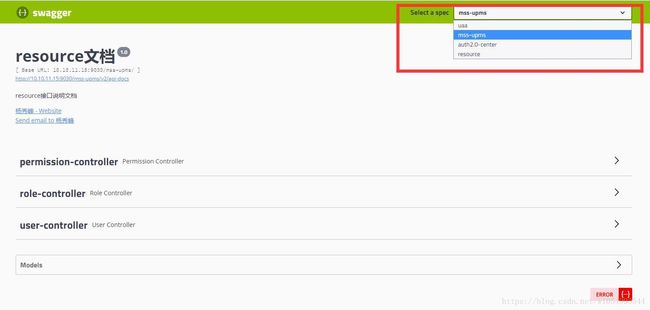发布了两年多的文章今天发现被CSDN关了, 理由如下:
现在迁移到看看是否有问题。
一、前言
从年初发表了Spring cloud微服务实战——基于OAUTH2.0统一认证授权的微服务基础架构 这篇博文后就没有更新了,很多评论疑问都没来得及回复,皆因这半年来快忙成狗了。到今天终于感觉轻松了一点。
二、 整合Swagger2
Swagger2大家肯定都用过,为什么我在这里还要提到呢,因为各个微服务都会提供自己的API文档,我们总不能一个地址一个地址去查吧,能不能有个统一的入口呢。这就是这节要讲的。
2.1 Zuul整合Swagger2
其他的都不说直接上代码
@Component
@Primary
public class GatewaySwaggerResourcesProvider implements SwaggerResourcesProvider {
private final RouteLocator routeLocator;
public GatewaySwaggerResourcesProvider(RouteLocator routeLocator) {
this.routeLocator = routeLocator;
}
@Override
public List get() {
List resources = new ArrayList<>();
List routes = routeLocator.getRoutes();
for (Route route:routes) {
resources.add(swaggerResource(route.getId(), route.getFullPath().replace("**", "v2/api-docs")));
}
return resources;
}
private SwaggerResource swaggerResource(String name, String location) {
SwaggerResource swaggerResource = new SwaggerResource();
swaggerResource.setName(name);
swaggerResource.setLocation(location);
swaggerResource.setSwaggerVersion("2.0");
return swaggerResource;
}
}
SwaggerResourcesProvider 是资源提供者,我们重写他,把各个微服务的资源路径返回,即:resources.add(swaggerResource(route.getId(), route.getFullPath().replace("**", "v2/api-docs")));
参看InMemorySwaggerResourcesProvider写法,如下,默认是当前应用的/v2/api-docs。
@Autowired
public InMemorySwaggerResourcesProvider(
Environment environment,
DocumentationCache documentationCache) {
swagger1Url = environment.getProperty("springfox.documentation.swagger.v1.path", "/api-docs");
swagger2Url = environment.getProperty("springfox.documentation.swagger.v2.path", "/v2/api-docs");
swagger1Available = classByName("springfox.documentation.swagger1.web.Swagger1Controller").isPresent();
swagger2Available = classByName("springfox.documentation.swagger2.web.Swagger2Controller").isPresent();
this.documentationCache = documentationCache;
}
@Override
public List get() {
List resources = new ArrayList();
for (Map.Entry entry : documentationCache.all().entrySet()) {
String swaggerGroup = entry.getKey();
if (swagger1Available) {
SwaggerResource swaggerResource = resource(swaggerGroup, swagger1Url);
swaggerResource.setSwaggerVersion("1.2");
resources.add(swaggerResource);
}
if (swagger2Available) {
SwaggerResource swaggerResource = resource(swaggerGroup, swagger2Url);
swaggerResource.setSwaggerVersion("2.0");
resources.add(swaggerResource);
}
}
Collections.sort(resources);
return resources;
}
最后记得配置Swagger
@Configuration
@EnableSwagger2
public class Swagger2Config {
@Bean
public Docket createRestApi() {
return new Docket(DocumentationType.SWAGGER_2)
.apiInfo(apiInfo());
}
private ApiInfo apiInfo() {
return new ApiInfoBuilder()
.title("说明文档")
.description("接口说明文档")
.termsOfServiceUrl("")
.contact(new Contact("杨秀峰","[email protected]","[email protected]"))
.version("1.0")
.build();
}
}
到这来就完成了,运行网关,输入:http://10.10.11.15:9030/swagger-ui.html,即可看到如下:
红色部分下拉选择服务切换查看API文档。
三、Zuul权限控制
Spring cloud微服务实战(一)的Zuul只是做为一个路由,并没有做权限限制,具体的权限控制要到各个微服务自己实现,这样一来不免要有很多重复的工作。那么就把权限控制放在网关的进行。
注意: 我这里是基于到URL的细粒度的权限控制
Zuul到这里就充当了资源服务器的角色。
配置资源服务器:
@Configuration
@EnableResourceServer
public class SecurityConfig extends ResourceServerConfigurerAdapter {
@Autowired
private OAuth2WebSecurityExpressionHandler expressionHandler;
private static final String[] AUTH_WHITELIST = {
};
@Override
public void configure(HttpSecurity http) throws Exception {
http.authorizeRequests().antMatchers("/v2/api-docs","/uaa/**").permitAll();
ExpressionUrlAuthorizationConfigurer.ExpressionInterceptUrlRegistry registry = http
.authorizeRequests();
for (String au:AUTH_WHITELIST
) {
http.authorizeRequests().antMatchers(au).permitAll();
}
http.authorizeRequests().anyRequest().authenticated();
registry.anyRequest()
.access("@permissionService.hasPermission(request,authentication)");
}
@Override
public void configure(ResourceServerSecurityConfigurer resources) {
resources.expressionHandler(expressionHandler);
}
@Bean
public OAuth2WebSecurityExpressionHandler oAuth2WebSecurityExpressionHandler(ApplicationContext applicationContext) {
OAuth2WebSecurityExpressionHandler expressionHandler = new OAuth2WebSecurityExpressionHandler();
expressionHandler.setApplicationContext(applicationContext);
return expressionHandler;
}
}
注意如下这段
registry.anyRequest()
.access("@permissionService.hasPermission(request,authentication)");
我们自定义表达式决策。最终在WebExpressionVoter的vote方法的ExpressionUtils.evaluateAsBoolean会调用到hasPermission(request,authentication);
PermissionService的代码如下:
@Service("permissionService")
@Slf4j
public class PermissionServiceImpl implements PermissionService {
/**
* 可以做URLs匹配,规则如下
*
* ?匹配一个字符
* *匹配0个或多个字符
* **匹配0个或多个目录
* 用例如下
* https://www.cnblogs.com/zhangxiaoguang/p/5855113.html
*/
private AntPathMatcher antPathMatcher = new AntPathMatcher();
@Override
public boolean hasPermission(HttpServletRequest request, Authentication authentication) {
Object principal = authentication.getPrincipal();
String requestUrl = request.getRequestURI();
log.info("requestUrl:{}",requestUrl);
List grantedAuthorityList = (List) authentication.getAuthorities();
boolean hasPermission = false;
if (principal != null){
if (CollectionUtils.isEmpty(grantedAuthorityList)){
return hasPermission;
}
for (SimpleGrantedAuthority authority:grantedAuthorityList
) {
if (antPathMatcher.match(authority.getAuthority(),requestUrl)){
hasPermission = true;
break;
}
}
}
return hasPermission;
}
}
我这里只做了简单的URL校验,完善的应该是判断URL、Request Method是否一致等等,大家有更多的发挥空间。
最后记得在application.yml里配置
security:
basic:
enabled: false
oauth2:
resource:
user-info-uri: http://localhost:9060/user
prefer-token-info: false
更好的做法应该直接从redis获取用户信息,减少一次HTTP请求;后面再完善吧,今儿有点赖了。
结束
今天的内容就这些了。
Github
Github
Github
